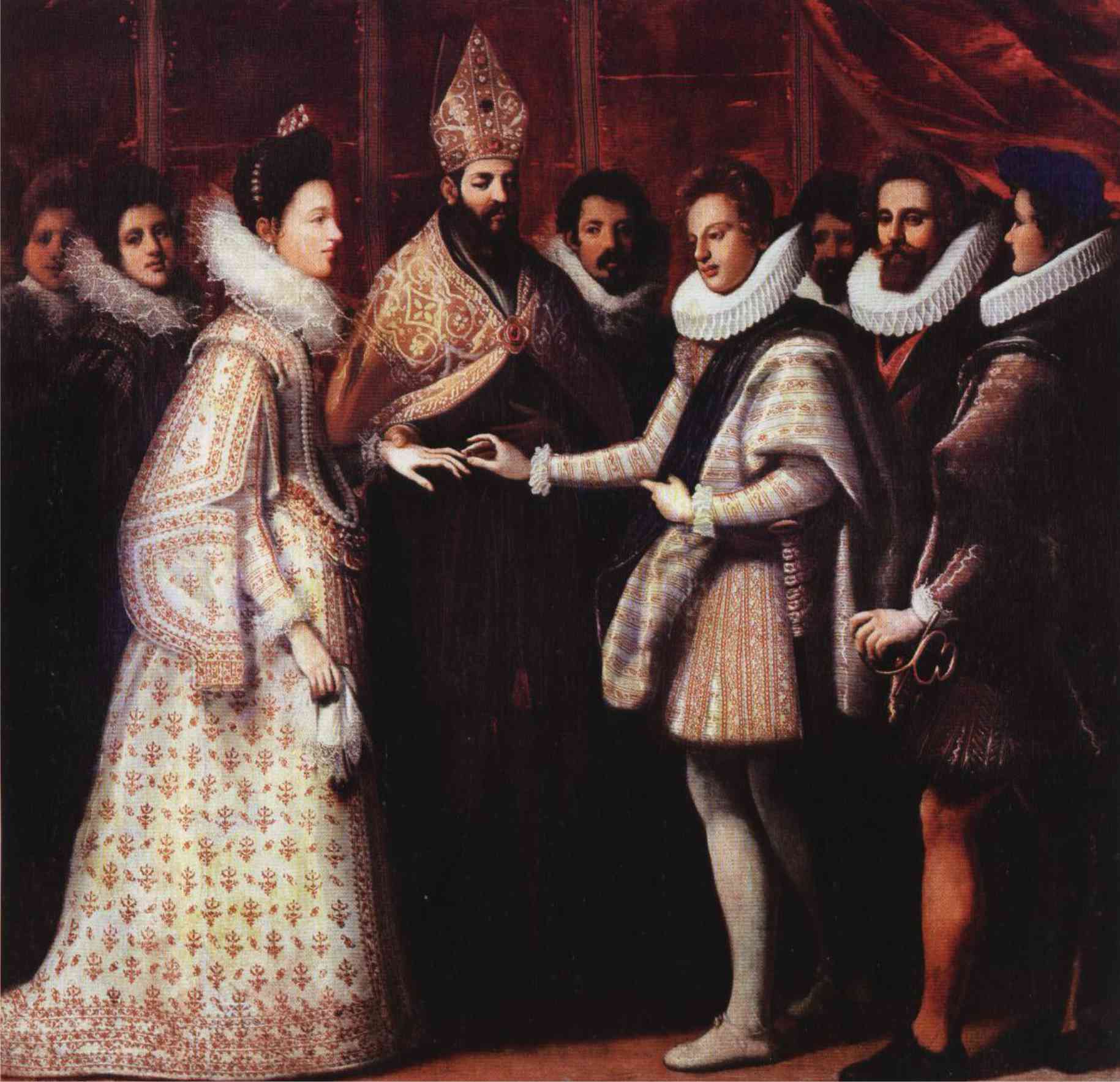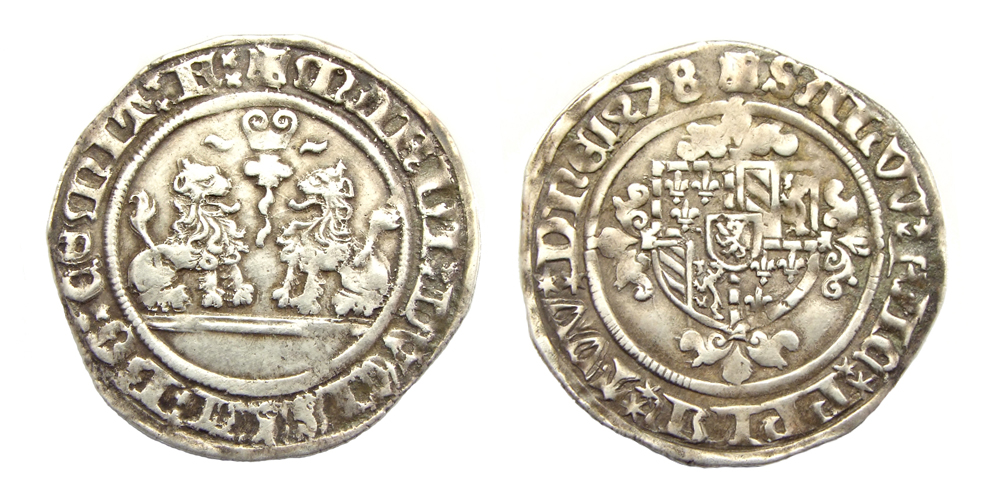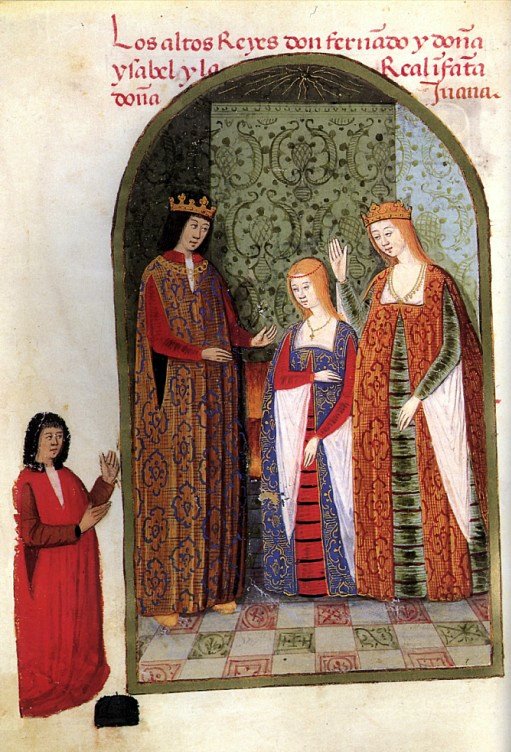|
Archduchess Eleanor Of Austria
Archduchess Eleanor of Austria (2 November 1534 – 5 August 1594) was Duchess of Mantua by marriage to William I, Duke of Mantua. She was the daughter of Ferdinand I, Holy Roman Emperor and Anna of Bohemia and Hungary. Life Eleanor was the eighth child and sixth daughter out of fifteen children born to Archduke Ferdinand of Austria (before his election as Holy Roman Emperor) and his wife Anna of Bohemia and Hungary. She was a sister of Johanna of Austria, who married Francesco I de' Medici, thus making Eleonora the aunt of Marie de' Medici, Queen of France. Life in Mantua She married William I, Duke of Mantua on 26 April 1561. At about age 5, Eleanor's daughter Anne Catherine became severely ill and nearly died. She contracted a high fever and her extremities began to swell. For two years she was ill. Finally Eleanor and William appealed to the Virgin Mary with deep prayer, promising to raise Anne as a child of Mary if she lived on. Soon Anne became healthy again. Eleano ... [...More Info...] [...Related Items...] OR: [Wikipedia] [Google] [Baidu] |
List Of Mantuan Consorts
Lady of Mantua House of Gonzaga, 1328–1433 Marchioness of Mantua House of Gonzaga, 1433–1530 Duchess of Mantua House of Gonzaga, 1530–1627 House of Gonzaga, Nevers line, 1627–1708 See also *List of consorts of Montferrat SourcesNORTHERN ITALY: MANTUA {{DEFAULTSORT:List Of Mantuan Consorts Duchesses of Mantua, Mantua House of Gonzaga Lists of duchesses, Mantuan, consorts ... [...More Info...] [...Related Items...] OR: [Wikipedia] [Google] [Baidu] |
Eleonora De' Medici
Eleanor de' Medici (28 February 1567 – 9 September 1611) was a Duchess of Mantua by marriage to Vincenzo I Gonzaga. She served as regent of Mantua 1595, 1597 and 1601, when Vincenzo served in the Austrian campaign in Hungary, and in 1602, when he left for Flanders for medical treatment. She was a daughter of Francesco I de' Medici and Joanna of Austria and the sister of Marie de' Medici, Queen of France. Early life Eleanor, born Eleonora, was born in Florence, Tuscany, Italy, on 28 February 1567, as the eldest child of Francesco I de' Medici and his first wife Archduchess Joanna. Her baptism took place the same year and was attended by Cardinal Innocenzo Ciocchi Del Monte an adoptive nephew of Pope Julius III. Cardinal Spinello de' Benci performed the ceremony on behalf of Pope Pius V. The baptism was celebrated also with hunting excursions and parties. It was at first believed Eleanor would marry Francis, Duke of Anjou, son of Henry II of France and Catherine de' Med ... [...More Info...] [...Related Items...] OR: [Wikipedia] [Google] [Baidu] |
Gaston De Foix, Count Of Candale
Gaston de Foix (1448 – 25 March 1500), Earl of Kendal and Count of Benauges, was a French nobleman in the last decades of the Middle Ages. He was a cadet member of the important Foix family in Southern France. He was a son of John de Foix, 1st Earl of Kendal and Margaret Kerdeston. Gaston succeeded as the Count of Benauges in France. As an heir of John de Foix, Earl of Kendal, he also continued to claim that English peerage and therefore was styled ''Comte de Candale''. He firstly married ''Infanta'' Catherine of Navarre, the youngest daughter of Gaston IV, Count of Foix, and Eleanor of Navarre. They had four children: *Gaston de Foix, 3rd Count of Candale. *Jean de Foix, Archbishop of Bordeaux. *Pierre de Foix, died without issue. * Anne of Foix-Candale, married King Vladislaus II of Hungary. In 1494, he remarried with Isabelle of Albret, daughter of Alain I of Albret. They had four children: *Alain de Foix, married Françoise dite de Montpezat des Prez. *Louise de Fo ... [...More Info...] [...Related Items...] OR: [Wikipedia] [Google] [Baidu] |
Elizabeth Of Austria (1436–1505)
Elizabeth of Austria (german: Elisabeth von Habsburg; pl, Elżbieta Rakuszanka; lt, Elžbieta Habsburgaitė; c. 1436 – 30 August 1505) was Queen of Poland and Grand Duchess of Lithuania as the wife of King Casimir IV of Poland. Orphaned at an early age, she spent her childhood in the court of Holy Roman Emperor Frederick III. As one of the three surviving grandchildren of Emperor Sigismund, she had a strong claim to the kingdoms of Hungary and Bohemia. That made her an attractive bride for a Polish prince. The Polish nobility, seeking to increase Polish influence in Hungary and Bohemia, pursued marriage with Elizabeth since she was born and finally succeeded in 1454. Her marriage to Casimir was one of the most successful royal marriages in Poland. She gave birth to thirteen children, eleven of whom survived to adulthood. Four of her sons were crowned as kings. Early life Tumultuous childhood Elisabeth was the daughter of Albert II of Germany, Archduke of Austria, and his ... [...More Info...] [...Related Items...] OR: [Wikipedia] [Google] [Baidu] |
Casimir IV Jagiellon
Casimir IV (in full Casimir IV Andrew Jagiellon; pl, Kazimierz IV Andrzej Jagiellończyk ; Lithuanian: ; 30 November 1427 – 7 June 1492) was Grand Duke of Lithuania from 1440 and King of Poland from 1447, until his death. He was one of the most active Polish-Lithuanian rulers, under whom Poland, by defeating the Teutonic Knights in the Thirteen Years' War recovered Pomerania, and the Jagiellonian dynasty became one of the leading royal houses in Europe. The great triumph of his reign was bringing Prussia under Polish rule. The rule of Casimir corresponded to the age of "new monarchies" in western Europe. By the 15th century, Poland had narrowed the distance separating it from western Europe and become a significant factor in international relations. The demand for raw materials and semi-finished goods stimulated trade, producing a positive balance, and contributed to the growth of crafts and mining in the entire country. He was a recipient of the English Order of the Gar ... [...More Info...] [...Related Items...] OR: [Wikipedia] [Google] [Baidu] |
Isabella I Of Castile
Isabella I ( es, Isabel I; 22 April 1451 – 26 November 1504), also called Isabella the Catholic (Spanish: ''la Católica''), was Queen of Castile from 1474 until her death in 1504, as well as Queen consort of Aragon from 1479 until 1504 by virtue of her marriage to King Ferdinand II of Aragon. Reigning together over a dynastically unified Spain, Isabella and Ferdinand are known as the Catholic Monarchs. After a struggle to claim the throne, Isabella reorganized the governmental system, brought the crime rate to the lowest it had been in years, and unburdened the kingdom of the enormous debt her half-brother King Henry IV had left behind. Isabella's marriage to Ferdinand in 1469 created the basis of the ''de facto'' unification of Spain. Her reforms and those she made with her husband had an influence that extended well beyond the borders of their united kingdoms. Isabella I of Castile and Ferdinand II of Aragon are known for being the first monarchs to be referred to a ... [...More Info...] [...Related Items...] OR: [Wikipedia] [Google] [Baidu] |
Ferdinand II Of Aragon
Ferdinand II ( an, Ferrando; ca, Ferran; eu, Errando; it, Ferdinando; la, Ferdinandus; es, Fernando; 10 March 1452 – 23 January 1516), also called Ferdinand the Catholic (Spanish: ''el Católico''), was King of Aragon and List of Sardinian monarchs, Sardinia from 1479, King of Sicily from 1468, King of Naples (as Ferdinand III) from 1504 and King of Navarre (as Ferdinand I) from 1512 until his death in 1516. He was also the nominal Duke of the ancient Duchy, Duchies of Duchy of Athens, Athens and Duchy of Neopatras, Neopatria. He was King of Castile, King of Castile and León (as Ferdinand V) from 1475 to 1504, alongside his wife Queen Isabella I. From 1506 to 1516, he was the Regent of the Crown of Castile, making him the effective ruler of Castile. From 1511 to 1516, he styled himself as Imperator, ''Imperator totius Africa'' (Emperor of All Africa) after having conquered Kingdom of Tlemcen, Tlemcen and making the Zayyanid dynasty, Zayyanid Sultan, Abu Abdallah V, his v ... [...More Info...] [...Related Items...] OR: [Wikipedia] [Google] [Baidu] |
Mary Of Burgundy
Mary (french: Marie; nl, Maria; 13 February 1457 – 27 March 1482), nicknamed the Rich, was a member of the House of Valois-Burgundy who ruled a collection of states that included the duchies of Limburg, Brabant, Luxembourg, the counties of Namur, Holland, Hainaut and other territories, from 1477 until her death in 1482. As the only child of Charles the Bold, Duke of Burgundy, and his wife Isabella of Bourbon, she inherited the Burgundian lands at the age of 19 upon the death of her father in the Battle of Nancy on 5 January 1477. In order to counter the appetite of the French king Louis XI for her lands, she married Maximilian of Austria. The marriage kept large parts of the Burgundian lands from disintegration, but also changed of the dynasty from the Valois to the Habsburg (the Duchy of Burgundy itself soon became a French possession). This was a turning point in European politics, leading to a French–Habsburg rivalry that would endure for centuries. Early ye ... [...More Info...] [...Related Items...] OR: [Wikipedia] [Google] [Baidu] |
Maximilian I, Holy Roman Emperor
Maximilian I (22 March 1459 – 12 January 1519) was King of the Romans from 1486 and Holy Roman Emperor from 1508 until his death. He was never crowned by the pope, as the journey to Rome was blocked by the Venetians. He proclaimed himself Elected Emperor in 1508 ( Pope Julius II later recognized this) at Trent, thus breaking the long tradition of requiring a Papal coronation for the adoption of the Imperial title. Maximilian was the son of Frederick III, Holy Roman Emperor, and Eleanor of Portugal. Since his coronation as King of the Romans in 1486, he ran a double government, or ''Doppelregierung'' (with a separate court), with his father until Frederick's death in 1493. Maximilian expanded the influence of the House of Habsburg through war and his marriage in 1477 to Mary of Burgundy, the ruler of the Burgundian State, heir of Charles the Bold, though he also lost his family's original lands in today's Switzerland to the Swiss Confederacy. Through marriage of his son ... [...More Info...] [...Related Items...] OR: [Wikipedia] [Google] [Baidu] |
Anne Of Foix-Candale
Anna of Foix-Candale (1484 – 26 July 1506) was Queen of Hungary and Bohemia as the third wife of King Vladislaus II. Biography Anne was the daughter of Gaston of Foix, Count of Candale and Infanta Catherine of Navarre. Her mother was the youngest daughter of Queen Eleanor of Navarre and Gaston IV, Count of Foix. Anne grew up at the French royal court at Blois. She was educated in Latin and the Classics. Louis I d'Orléans, Duke of Longueville, first cousin once removed of King Louis XII of France, is reported to have been in love with her and wished to marry her, but he was prevented from doing so because an illustrious political marriage was planned for Anne. The elderly, twice-divorced and childless king Vladislaus II of Hungary of the Jagiellon dynasty had been searching for a wife capable of giving him a son. His sights were set on a powerful alliance, and Anne, a member of the upper nobility of France related to several royal families, was a good choice. Anne wa ... [...More Info...] [...Related Items...] OR: [Wikipedia] [Google] [Baidu] |
Vladislaus II Of Hungary
Vladislaus II, also known as Vladislav, Władysław or Wladislas ( hu, II. Ulászló; 1 March 1456 – 13 March 1516), was King of Bohemia from 1471 to 1516, and King of Hungary and Croatia from 1490 to 1516. As the eldest son of Casimir IV Jagiellon, he was expected to inherit Poland and Lithuania. George of Poděbrady, the Hussite ruler of Bohemia, offered to make Vladislaus his heir in 1468. George needed Casimir IV's support against the rebellious Catholic noblemen and their ally, Matthias Corvinus, King of Hungary. The Diet of Bohemia elected Vladislaus king after George's death, but he could only rule Bohemia proper, because Matthias (whom the Catholic nobles had elected king) occupied Moravia, Silesia and both Lusatias. Vladislaus tried to reconquer the four provinces with his father's assistance, but Matthias repelled them. Vladislaus and Matthias divided the Crown of Bohemia in the Peace of Olomouc in 1479. The estates of the realm had strengthened their position ... [...More Info...] [...Related Items...] OR: [Wikipedia] [Google] [Baidu] |
Joanna Of Castile
Joanna (6 November 1479 – 12 April 1555), historically known as Joanna the Mad ( es, link=no, Juana la Loca), was the nominal Queen of Castile from 1504 and Queen of Aragon from 1516 to her death in 1555. She was married by arrangement to Philip the Handsome, Archduke of Austria, of the House of Habsburg, on 20 October 1496.Bethany Aram, ''Juana the Mad: Sovereignty and Dynasty in Renaissance Europe'' (Baltimore, Johns Hopkins UP, 2005), p. 37 Following the deaths of her brother, John, Prince of Asturias, in 1497, her elder sister Isabella in 1498, and her nephew Miguel in 1500, Joanna became the heir presumptive to the crowns of Castile and Aragon. When her mother, Queen Isabella I of Castile, died in 1504, Joanna became Queen of Castile. Her father, King Ferdinand II of Aragon, proclaimed himself Governor and Administrator of Castile.Bergenroth, G A, Introduction. Letters, Despatches, and State Papers to the Negotiations between England and Spain. Suppl. to vols ... [...More Info...] [...Related Items...] OR: [Wikipedia] [Google] [Baidu] |







